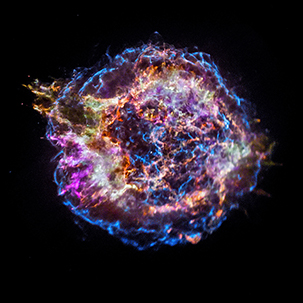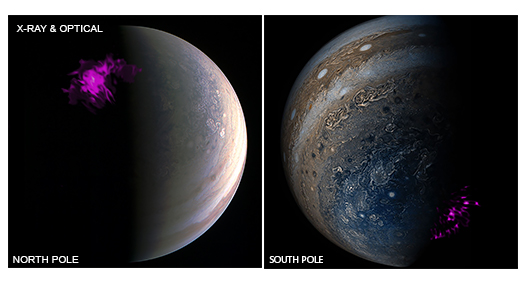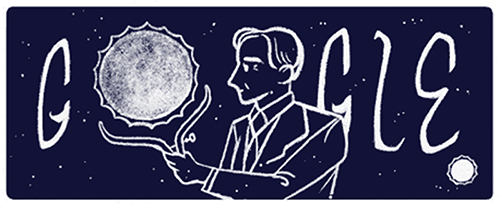Chandra Reveals the Elementary Nature of Cassiopeia A
Where do most of the elements essential for life on Earth come from? The answer: inside the furnaces of stars and the explosions that mark the end of some stars' lives.
Astronomers have long studied exploded stars and their remains — known as "supernova remnants" — to better understand exactly how stars produce and then disseminate many of the elements observed on Earth, and in the cosmos at large.
Due to its unique evolutionary status, Cassiopeia A (Cas A) is one of the most intensely studied of these supernova remnants. A new image from NASA's Chandra X-ray Observatory shows the location of different elements in the remains of the explosion: silicon (red), sulfur (yellow), calcium (green) and iron (purple). Each of these elements produces X-rays within narrow energy ranges, allowing maps of their location to be created. The blast wave from the explosion is seen as the blue outer ring.
X-ray telescopes such as Chandra are important to study supernova remnants and the elements they produce because these events generate extremely high temperatures — millions of degrees — even thousands of years after the explosion. This means that many supernova remnants, including Cas A, glow most strongly at X-ray wavelengths that are undetectable with other types of telescopes.
Chandra's sharp X-ray vision allows astronomers to gather detailed information about the elements that objects like Cas A produce. For example, they are not only able to identify many of the elements that are present, but how much of each are being expelled into interstellar space.
Giant Black Hole Pair Photobombs Andromeda Galaxy

Professor Emily Levesque & Trevor Dorn-Wallenstein
Trevor is a third-year Astronomy graduate student at the University of Washington in Seattle, working with Professor Emily Levesque. He led the paper that is the subject of our latest press release on the discovery of a giant black hole pair that is photobombing the Andromeda Galaxy. He is interested in massive stars and young stellar populations, as well as playing the drums and baking cookies.
It’s funny how a simple case of mistaken identity can lead to the discovery of exotic objects hiding as unassuming dots in the sky.
My advisor, Professor Emily Levesque, and I, both astronomers at the University of Washington, were interested in finding star systems called red supergiant X-ray binaries. These systems consist of a compact object, like a neutron star or black hole, and a red supergiant — massive stars like Betelgeuse that are 10-20 times the mass of our sun but much less hot. Mass from the supergiant is lost to the compact object, where it should heat up and glow brightly in X-rays. While no such systems have been conclusively identified, red supergiant X-ray binaries could be used to better understand the evolution of the most extreme star systems.
A New Stellar X-ray "Reality" Show Debuts
A new project using data from NASA’s Chandra X-ray Observatory and other telescopes allows people to navigate through real data of the remains of an exploded star for the first time.
This three-dimensional virtual reality (VR) project with augmented reality (AR) allows users to explore inside the leftovers from actual observations of the supernova remnant called Cassiopeia A. Cassiopeia A (Cas A, for short) is the debris field of a massive star that blew itself apart over 400 years ago.
The new 3D VR/AR project of Cas A is a collaboration between the Chandra X-ray Center in Cambridge, Mass., and Brown University in Providence, RI, and will provide new opportunities for public communications, informal education, and research.
The Dynamic Duo: Jupiter's Independently Pulsating X-ray Auroras
Jupiter's intense northern and southern lights, or auroras, behave independently of each other according to a new study using NASA's Chandra X-ray and ESA's XMM-Newton observatories.
Chandra Celebrates Dark Matter Day
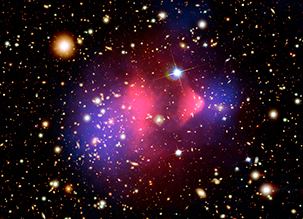
The Bullet Cluster
While October 31st is obviously known best (at least in the United States) as the day to celebrate Halloween, this year it takes on an extra meaning. Scientists and science communicators have designated October 31, 2017 to be "Dark Matter Day".
Dark matter is the mysterious and pervasive substance that constitutes most of the matter in our Universe. Although scientists have made progress in better understanding dark matter, the true nature of this invisible material remains elusive.
NASA’s Chandra X-ray Observatory plays an important role in the search to learn about dark matter. For example, in 2006 Chandra’s observations of the Bullet Cluster (officially known as 1E 0657-56) helped provide direct proof for the existence of dark matter, in a violent merger between two galaxy clusters. More recently, astronomers have used Chandra to test one model for dark matter by studying a collection of galaxy clusters.
Happy Birthday, Chandra! Google Gave You a Doodle!
Since 1998, Google has changed the logo on its homepage in honor of various holidays, anniversaries, and other events. By clicking on Google’s "Doodle", users are taken to links about that particular subject.
Chandra Makes First Detection of X-rays from a Gravitational Wave Source: Interview with Chandra Scientist Daryl Haggard
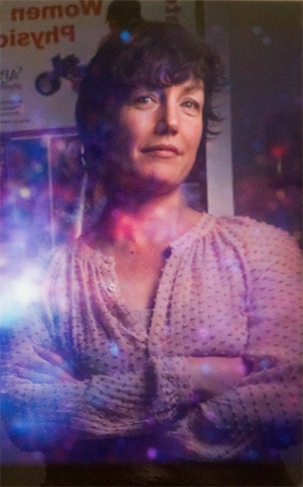
Chandra Scientist Daryl Haggard
Daryl Haggard is an Assistant Professor of Physics at McGill University. She is an observational astronomer and received her PhD at the University of Washington (Seattle, WA). She and her group study Sagittarius A*, the supermassive black hole at the heart of our Milky Way Galaxy. Haggard's team uses radio, submillimeter, near infrared, and X-ray telescopes to probe Sgr A*'s exotic environment, where strong gravity plays a key role. Her team also studies the interplay between distant growing supermassive black holes, or active galactic nuclei, and their host galaxies. And when opportunity knocks, she and her group search for X-ray flashes emitted from neutron stars and black holes when they collide. These collisions send ripples through space-time, gravitational waves, now being detected by LIGO and Virgo.
What are gravitational waves? What are neutron stars?
Gravitational waves are “jiggles” in the fabric of space-time. They are like sound waves traveling through the air around me while I talk, but gravitational waves race through the Universe at the speed of light and carry LOTS of energy away from their source.
Meanwhile, neutron stars are basically big balls of neutrons. They are born during supernova explosions when the gravity on the inside of a star is so intense it forces the electrons into the protons, making neutrons. Actually, the fusion that happens during these supernovas is how atoms like oxygen, iron, all the stuff we need for life, gets built. Neutron stars weigh two or three times the mass of our Sun, but are only the size of a modest city, like Boston or Montreal. They are incredibly dense objects. For example, if you took the Earth’s whole human population and squished it into an object the size of a sugar cube, we’d all become a neutron star.
Chandra Makes First Detection of X-rays from a Gravitational Wave Source: Interview with Chandra Scientist Wen-fai Fong
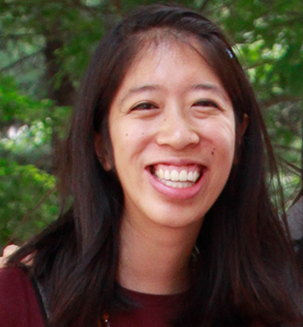
Chandra Scientist Wen-fai Fong
Originally from Rochester, NY, Wen-fai Fong received double Bachelor's degrees in Physics and Biology at the Massachusetts Institute of Technology, and earned her Ph.D. in Astronomy & Astrophysics from Harvard University. She was subsequently awarded an Einstein Postdoctoral Fellowship, which she took to the University of Arizona's Steward Observatory. She is currently a Hubble Postdoctoral Fellow at Northwestern University and will begin her appointment as Assistant Professor there in Fall 2018. Wen-fai is excited about unraveling the mysteries enshrouding cosmic explosions, including gamma-ray bursts and gravitational wave sources.
What are gravitational waves? What are neutron stars?
Gravitational waves are best described as ripples in space-time. To envision these merging compact objects, I always try to think of two round objects on a very flexible trampoline, rolling and rolling around each other. For the most flexible of trampolines, they will create some sort of pattern outward, while also spiraling toward each other and eventually colliding. It’s an oversimplified version, but that is how I best imagine what is going on.
In reality, the specific properties of the system — the masses, spins, orbital orientation, and distance — determine the very special pattern of the gravitational waves that are radiated from a system. Scientists then match that pattern against a gigantic bank of patterns by the gravitational wave experts who are able to determine very specific properties of the system. So it is a very neat and elegant problem that is made possible by many years of hard work.
Chandra Makes First Detection of X-rays from a Gravitational Wave Source: Interview with Chandra Scientist Raffaella Margutti

Chandra Scientist Raffaella Margutti
Raffaella Margutti obtained a PhD degree in Physics and Astronomy from the University of Milano Bicocca, Italy, in 2010, working on the broad-band (radio to gamma-ray) emission from relativistic jets in gamma-ray bursts within the Swift team. She then worked as a postdoctoral fellow at the Institute for Theory and Computation (ITC) at Harvard University, and then moved in 2015 for one year to New York University as James Arthur Fellow. Raffaella began a faculty position at Northwestern University (Physics and Astronomy) in 2016. She has been working in the field of Astronomical transients for more than a decade, with a wide range of expertise including, Stellar Explosions, Gamma-Ray bursts, Tidal Disruption Events, Stellar Outburst, and now, counterparts to GW.
What are gravitational waves?
Gravitational Waves are ripples in space-time that become particularly strong when very violent event in our Universe happen, like the merge of two very peculiar stars that we call neutron stars (NS). NS are what get left behind after a big star like 10 times the Sun ends its life with a big explosion.
Chandra Makes First Detection of X-rays from a Gravitational Wave Source: Interview with Chandra Scientist Eleonora Nora Troja

Chandra Scientist Eleonora Nora Troja
Eleonora Nora Troja was born and raised in Palermo, Sicily. After completing her PhD at the University of Palermo, she moved to NASA Goddard Space Flight Center as a NASA Postdoctoral Program Fellow. Her main research interest is the study of gamma-ray bursts, and in particular the connection between short duration gamma-ray bursts, neutron star mergers and gravitational waves. Beside her studies, she also leads the Swift Guest Investigator Program and serves as co-chair for the Athena mission working groups.
What are gravitational waves?
Gravitational waves are ripples in the fabric of space and time. According to Einstein’s theory of general relativity, every moving object actually emits a tiny amount of gravitational waves, but the signal is usually too small for us to detect. In order for us to detect gravitational waves, we need to wait for catastrophic events like the collision of two neutron stars. This brings to the second question, what are neutron stars? Neutron stars are some of the most exotic and dense objects in our Universe. These stars weight as much as our Sun but they are much smaller in size. A neutron star can extend up to 15-17 miles across, this is more or less the size of Washington D.C.

